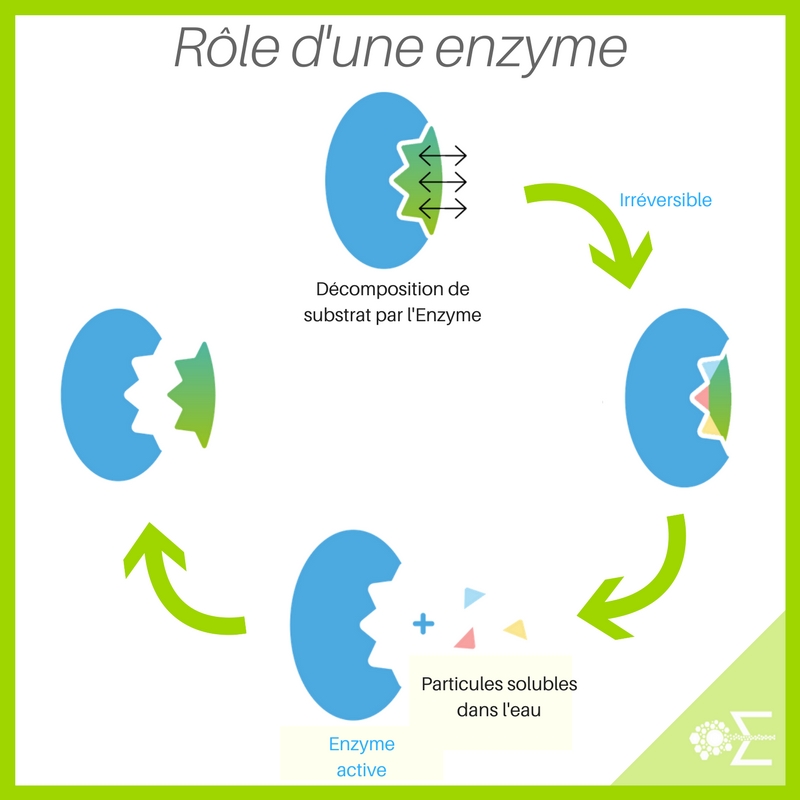Enzyme Reading Worksheet
Definition of an Enzyme
To function, any organism needs energy.
The production of this energy is based in particular on enzymes, proteins with catalytic properties and responsible for accelerating reactions in our cells.
Almost 100% of the metabolic processes in our body require these molecules in order to function properly and therefore ensure the maintenance of life.
Without enzyme , you run out of fuel!
These small elements perform a large number of functions in living things:
- they contribute to the regulation of cellular processes,
- intervene in the generation of movements,
- play an important role in the human digestive system,
- contribute, for example, to the degradation of starch, etc.
If they are essential in humans, they are found naturally in other living organisms, such as plants, animals, microorganisms.
You will easily understand the power that such a molecule can provide for professional applications .
Let us discover, in detail, the characteristics and the functioning of these essential proteins in extremely varied fields of application.
Enzymes: a complex process
The enzymes can act alone or grouped into complex . Like all proteins, they are made up of polypeptide chains (a set of proteins that are nested within each other).
It is the detail of these chains, also called “amino acid sequence” , which determines its structure, which in turn defines its function, that is to say its catalytic properties or its role in the organism. Inside, only a tiny part is essential: it is the active principle, the place where the enzyme will bind to its substrate and be able to start the reaction of which it has the secret.
How does an enzyme work?
When talking about enzymology, the term “substrate” often appears . What is that ?
It's very simple: if the enzyme were a key, the substrate would be the lock in which it fits.
These proteins therefore bind to their substrates thanks to their binding sites, complementary elements in terms of both shapes and electrical charges (they attract each other like two magnets). Once the 2 components are nested, the reaction can start.
But enzymes don't just have the role of catalyst or reaction accelerator: they are also biological scissors that cut or break down substrates.
Note that beyond this morphological compatibility between the two, the enzyme can only cut its substrate, or even its substrate family.
For example, the enzyme sucrase (or invertase) will break down the sucrose substrate to create simple sugars, namely glucose and fructose.
Sometimes need a little help ...
While some work alone in total autonomy, others need help to become active! This is called cofactors or coenzymes . The enzymes free of cofactor are called apoproteins, those associated with a cofactor are named holoproteins.
Some cofactors such as riboflavin or folic acid are vitamins, not synthesized by the body and provided through food. They are regenerated regularly, thus ensuring a constant concentration in the body.
5 ways to control enzyme activity
- Regulation: enzymatic activity can first of all be regulated by other molecules.
- Sleeping: the enzyme can either be activated or inhibited by other molecules.
- Its quantity can also be managed by the cells which decide to produce more or less according to the needs.
- Post-translational modification: in summary, the enzyme exists in 2 forms: “on standby” when it moves, active when it meets its substrate.
- Specialization by cell: finally, specialization by cell or by organ makes it possible to modulate the level and location of activity of these molecules in order to optimize their effect.
Without a doubt, therefore, enzymes are a useful model for understanding the complex works of nature .
These molecular machines (without which life would not exist) are responsible for triggering reactions in the body.
Today, it should be known that in addition to natural enzymes, many synthetic versions are created in the laboratory to improve their activity, develop new properties, with a view to adapting them to the industrial sector and to produce, among other things, organic products. more and more effective natural maintenance.
To learn more about enzymes, discover the other articles on our blog on this topic:
- Enzymes and professional solutions
- All about enzymatic activation
- What is the "enzymatic process"?
- Enzymatic ecosolution: a sustainable solution for the transition
Recent Posts
-
CRISPR/Cas9 Gene Editing Kits: Unlocking the Genome
Gene Editing Kits for CRISPR/Cas9: An Effective Research and Medical ToolWith the advent of potent g …25th Mar 2024 -
Workstations and equippement
AGTC offers extra discount on new lab installationsThrough our Partnets, Biodas, Gentaur, Genprice a …9th May 2022 -
AGTC Product range
Ask a quotation for bulk reagentsAGTC has the best rates for UK and export for the following instrum …14th Apr 2022



